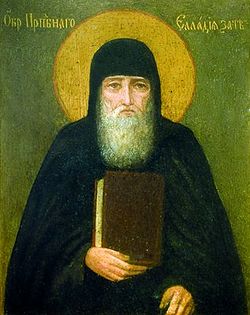Top Qs
Timeline
Chat
Perspective
October 4 (Eastern Orthodox liturgics)
From Wikipedia, the free encyclopedia
Remove ads
October 3 - Eastern Orthodox liturgical calendar - October 5

All fixed commemorations below celebrated on October 17 by Eastern Orthodox Churches on the Old Calendar.[note 1]
For October 4th, Orthodox Churches on the Old Calendar commemorate the Saints listed on September 21.
Saints
- Hieromartyr Hierotheus of Athens, first Bishop of Athens (1st century)[1][2][3][4][note 2]
- Venerable Theodore the Wonderworker, Bishop of Tamassos, Cyprus (2nd century)[1][3][5]
- Martyrs Gaius,[6] Faustus,[7] Eusebius,[8] and Chaeremon, Deacons, of Alexandria (3rd century)[1][9][10][note 3] (see also: October 3)
- Martyrs Domnina and her daughters Berenice (Bernice) and Prosdoce, of Syria (302)[1][3][12][13][note 4]
- Martyr Adauctus (c. 312) and his daughter St. Callisthene (c. 318), of Ephesus.[1][3][15][16][note 5]
- Venerable Paul the Simple (c. 339)[18] and Venerable Ammon (350),[3][19][20][21] of Egypt, disciples of St. Anthony the Great.[1][10][22]
- Hieromartyr Peter of Capitolia, Bishop of Bostra in Arabia (715)[1][3][10][22][23][24]
- Venerable John (Lampadistes) of Cyprus (10th century)[1][3][10][25]
- Saint Vladimir Yaroslavich, prince of Novgorod (1052),[22][26] and his mother St. Anna of Novgorod (Ingegerd Olofsdotter of Sweden) (1050)[1][10][27]
Remove ads
Pre-Schism Western saints
- Saint Petronius of Bologna, Bishop of Bologna (c. 450)[28][note 6][note 7]
- Saint Quintius of Tours (Quentin), a citizen of Tours, martyred at L'Indrois near Montrésor (6th century)[28][note 8][note 9]
- Saint Aurea, a Syrian who moved to France and became Abbess of St Martial in Paris, where she remained for thirty-three years (666)[11][28][30]
Post-Schism Orthodox saints
- Saints Helladius and Onesimus of the Near Caves in Kiev (12th-13th centuries)[1][10][22]
- Saint Ammon, recluse, of the Far Caves in Kiev (13th century)[1][10][22][27][31]
- Saint Stephen Stiljanovic, despot of Srem, Serbia (1540),[22] and his wife St. Elena (Elizabeth in monasticism) (c. 1543)[1][10][32]
- Saints Jonah and Nectarius, monks, of Kazan (16th century)[1][10][33]
- Hieromartyr Evdemoz I, Catholicos of Georgia (1642)[1][10][34]
- Saint Peter (Michurin) of Kuznetsk, Siberia (1820)[1][10]
New Martyrs and Confessors
- New Hieromartyr Demetrius Voznesensky, Priest (1918)[10][22][35]
- New Hieromartyrs Nicholas Vereschagin, Michael Tverdovsky, Jacob Bobirev[36] and Tikhon Archangelsky, Priests (1937)[10][22]
- New Hieromartyr Basil (Tsvetkov), Archimandrite, of Stary Kelets, Ryazan (1937)[1][10][22][37]
- Saint Khionia Archangelsky, Confessor (1945)[10][22][38]
- New Hiero-confessor Barsanuphius (Yurchenko) of Kherson (1954)[1]
Other commemorations
Icon gallery
- Hieromartyr Hierotheus of Athens, first Bishop of Athens.
- Hieromartyr Hierotheus of Athens, first Bishop of Athens.
- Martyrs Gaius, Faustus, Eusebius and Chaeremon, Deacons of Alexandria.
- Martyr Adauctus and his daughter St. Callisthene of Ephesus.
- Venerable Paul the Simple of Egypt.
- Venerable Ammon of Egypt.
- St. Stephen Stiljanovic, of Srem, Serbia.
- Hieromartyr Evdemoz I, Catholicos of Georgia.
- St. Helladius of Kiev.
Remove ads
Notes
- The notation Old Style or (OS) is sometimes used to indicate a date in the Julian Calendar (which is used by churches on the "Old Calendar").
The notation New Style or (NS), indicates a date in the Revised Julian calendar (which is used by churches on the "New Calendar"). - "Adauctus, a citizen of Ephesus, suffered martyrdom in Mesopotamia, in the persecution of Maximin. His daughter Callisthene cut her hair short, disguised herself as a young man, and concealed herself in Nicomedia. After eight years she went to Thrace, and lodged with a woman who had a daughter with delicate eyes. Callisthene, by careful attention, healed the girl, and the mother desired to marry the two, that they might settle in her house and be the comfort of her old age. Callisthene was then obliged to tell her story. She went next to Constantia, the wife of Licinius, and told her her case, and the empress procured for her the restoration of her father's property which had been confiscated. Callisthene recovered the body of her father, brought it to Ephesus, and built a church over it."[17]
- Probably the son of a prefect in France, he visited the monks in Palestine and prayed at the holy places. He became Bishop of Bologna in Italy and built the monastery of St Stephen there, reproducing the general lines of the buildings of the holy places in Jerusalem.
- "Quintin of Tours, not to be confounded with his more famous namesake, was a native of Meaux, who came to Tours when Gunthram was King of Paris. The wife of his master fell desperately in love with him, and because he indignantly rejected her overtures she compassed his murder, which took place at L'Indrois, near Montresor."[29]
- A citizen of Tours in France, he worked at the court of the Frankish king. The reigning queen tried to seduce him and had him assassinated at L'Indrois near Montresor.
- See: (in Russian) Собор Казанских святых. Википедии. (Russian Wikipedia).
Remove ads
References
Sources
Wikiwand - on
Seamless Wikipedia browsing. On steroids.
Remove ads









